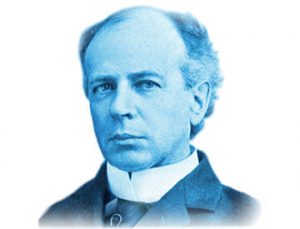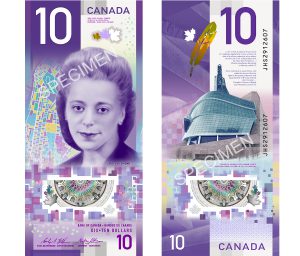The Bank of Canada’s independent seven-person advisory council has unveiled its shortlist of eight iconic Canadians who could be featured on the next $5 banknote.
It comes after the council’s evaluation of more than 600 eligible nominees submitted by nearly 45,000 Canadians between late January and mid-March. The shortlist was unveiled on Nov. 9 before being submitted to Chrystia Freeland, finance minister and deputy prime minister, who will announce the next portrait subject of the new $5 note in early 2021.
“Each of these people deserve recognition for their remarkable contributions to Canada. They all overcame barriers, fought for their ideals, and have inspired generations. I invite all Canadians to learn about the stories of these incredible people,” said Freeland, who was sworn in as the finance minister this August after Bill Morneau resigned amid an ethics scandal involving the federal government and WE Charity.
In alphabetical order, the shortlist includes:
- Pitseolak Ashoona (circa 1904/1908-83), who was a self-taught artist whose work has been exhibited internationally and held by museums and galleries throughout Canada;
- Robertine Barry (1863-1910), also known by her literary pseudonym Françoise, who was the first female French-Canadian journalist and an advocate for many social causes, including gender equality;
- Francis Pegahmagabow (1888-1952), also known by his Ojibwe name Binaaswi (“the wind that blows off”), a First World War veteran who was the most highly decorated Indigenous soldier in Canadian history;
- Won Alexander Cumyow (1861-1955), who was the first known Chinese-Canadian born in Canada and used his language skills to bridge the divide between Vancouver’s English-speaking and Chinese communities;
- Terry Fox (1958-81), who campaigned to raise awareness and funding for cancer research through his “Marathon of Hope,” which raised $24.7 million – $1 for every Canadian – by February 1981;
- Lotta Hitschmanova (1909-90), a Czech-born refugee who came to Canada in 1942 before becoming one of the country’s earliest grassroots humanitarians;
- Isapo-muxika (circa 1830-90), also known as Crowfoot, who was the leader of the Blackfoot Confederacy and a key figure in the Treaty 7 negotiations; and
- Frederick Ogilvie Loft (1861-1934), also known by his Mohawk name Onondeyoh, who was a chief, First World War veteran, activist and founder of the first pan-Canadian Indigenous organization in 1918.
“A list of eight names may seem like a very short list, but the selected nominees emerged from thoughtful considerations and deep deliberations to ensure it is a list we would all be proud to present and stand by with determination, whatever the end decision is,” reads a joint statement issued by the advisory council. “We deeply believe this list emphasizes the diverse contributions of Canadians to our shared history.”

Canada’s first francophone prime minister Sir Wilfrid Laurier is the current face of the country’s $5 banknote but will move to a higher denomination once the new bill is redesigned.
FOX LEADS THE WAY
Among the eight shortlist finalists, Fox, a native of Port Coquitlam, B.C., is the “run-away choice,” according to a recent Angus Reid Institute survey.
From Nov. 12-16, the online survey asked a representative randomized sample of 1,578 Canadian adults – all members of the Angus Reid Forum, the firm’s polling population – which nominee they would most like to see on the forthcoming $5 banknote.
About 57 per cent of respondents chose Fox, who was the top option in every region of the country.
Binaaswi was chosen by one in five respondents (21 per cent), including one-quarter of residents in Saskatchewan, Ontario and Atlantic Canada.
Crowfoot was also chosen by one in five respondents (19 per cent).
While more than three in five survey participants – and a majority in each region of the country – responded saying it is a good idea to change the face of the five, 37 per cent (including 57 per cent of past Conservative voters) said they disagree.
To read the full survey results, click here.
THE COUNCIL’S GUIDING PRINCIPLES
Unveiled in March, the seven council members “brought a wide range of perspectives and experiences to the deliberations, which were supported by historical and public opinion research,” according to a statement issued this November by the Bank of Canada. In compiling their shortlist, they followed a set of guiding principles, including:
- “positive change,” meaning the nominees should have changed Canada and Canadians for the better;
- “national icon,” meaning the nominees’ impact is known nationally across Canada;
- “universality,” meaning the nominees had an impact in Canada and reflective of Canadian values;
- “uniqueness,” meaning the nominees are distinctly Canadian and known beyond their local or regional communities; and
- “relevancy,” meaning the nominees had an impact that remains relevant today.
“Canadians put forward the names of hundreds of people who have changed Canada for the better,” said Bank of Canada Governor Tiff Macklem. “I thank the advisory council members for their thoughtful and thorough deliberations, and I look forward to seeing which of these eight remarkable individuals will be featured on our next $5 banknote.”
THE NEW BILL

The new $5 bill will be the second issue from the Bank of Canada’s as-of-yet-unnamed eighth banknote series. The first note (shown) featured Viola Desmond, the first Canadian woman to be portrayed on a regularly circulating Bank of Canada note.
Like the $10 note released in 2018 as part of the Bank of Canada’s as-of-yet-unnamed eighth banknote series, the new $5 bill will have a vertical design.
The series’ first note – the $10 bill featuring Black rights activist Viola Desmond – won the Bank Note of the Year Award from the International Bank Note Society earlier this year.
The series’ remaining notes ($20, $50 and $100) will follow every two or three years.
Canada’s first francophone prime minister Sir Wilfrid Laurier is the current face of the country’s $5 bill; however, he will be moved to a higher-value note – $50 or $100 – when they are redesigned in the coming years.
The current Frontiers series $5 note featuring Laurier alongside the Canadarm2 and two-armed Dextre robot will continue to circulate “for some time,” according to the central bank.
The design process for the new $5 bill will begin once the new portrait subject is chosen early next year.
Other portraits, including those of William Lyon Mackenzie King and Sir Robert Borden, will no longer be portrayed on Canadian banknotes once the entire series is issued.
The $20 note will continue to feature the reigning monarch.
To view the shortlist for the new $5 bill, visit bankofcanada.ca/banknotes/banknoteable-5/nominees.


2 Comments
Only my opinion, I mean no disrespect but Terry Fox is on a coin. We need to pay respects to other Canadians who have left such a profound impact on our country. And I believe the Mint would receive a lot of negativity if Terry Fox was on a bill also.
cattz from Canada, eh!
Sorry, should read Bank of Canada and not the Mint.